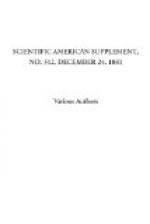ELECTRICITY.—What is it? Why, it is dynamic caloric. Now let us take this oxide of zinc (ZnO) and place it with charcoal in a reducing apparatus which stands on an insulated table; the apparatus is then heated, the carbon vaporizes, and this vapor of carbon (C) robs the oxide of zinc (ZnO) of its oxygen, leaving metallic zinc (Zn) and carbonic oxide (CO). Now, for every pound of zinc so formed 1,301 units C. of static caloric are transferred from the charcoal to the zinc and occluded in it. Hence we find that the 1,301 units C. of caloric which we took out of the zinc, and which we call electricity, is nothing else but the 1,301 units of static caloric which was contained in the charcoal and from it set free by oxidation and transferred to the zinc in the smelting process. Let us follow this matter a little further. Charcoal is made by burning wood under such conditions as eliminate the water and hydrogen and leave the carbon as a residuum which we call charcoal. Thus we find that the caloric contained in the charcoal, transferred from the charcoal to the zinc, and from it developed into what we call electricity, was previously embodied in the wood; and if we study the laws of vegetation, we find that the atmosphere being charged with carbonic acid (CO_{2}), the leaves of plants, shrubs, and trees, breathing, take in the CO_{2}, the sun rays decompose the CO_{2}, set free the oxygen, and supply the necessary amount of caloric for the condensed state of the carbon. Thus we find that the force which we term electricity, developed from the oxidation of zinc, or any other matter, by oxidation, primarily comes from the sun rays.
Coal is generally supposed to be of vegetable origin, and the caloric occluded in it is derived from the same source as that embodied in charcoal. Now when we burn coal under a steam boiler, the carbon and hydrogen are oxidized, and the static caloric set free. A portion of this caloric passes through the shell or tubes of the boilers, and increases the molecular velocity of the water; increased activity of the molecules tends to separate them to a greater distance from each other. When the molecular velocity of the water acquires the degree indicated by a temperature of 212 degrees F., the water passes from the fluid to the gaseous state, and in doing so expands to 1,696 times its bulk. Now if the steam so developed be confined under a pressure of 105 pounds to the square inch, the water will not vaporize until a molecular velocity is attained indicated by a temperature of 312 deg. F. (Spons’ “Engineering,” D2, page 418), and then the expansion is only 253 times its bulk. By using this steam, in a steam engine, the caloric in the steam tends to push the molecules of which it is composed into an ultimate expansion of 1,696 times the bulk of the water from which it was generated, and this force acts upon the piston and does the work. Thus we see that the steam engine is driven by the same force which produces the phenomena accredited to electricity.




